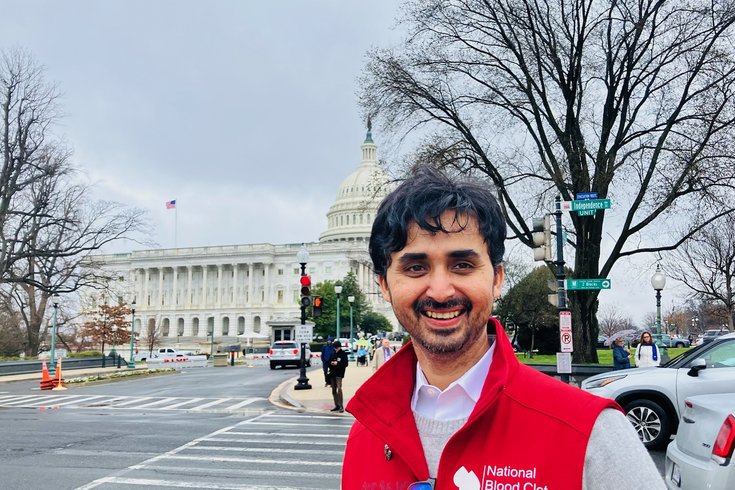
April 09, 2024
 Provide Image/Temple Health
Provide Image/Temple Health
Dr. Parth Rali, above, and Temple Health have endorsed federal legislation that aims to raise awareness about blood clot prevention. Blood clots can cause a pulmonary embolism, a sometimes fatal condition.
Temple Health is on a mission to raise awareness about one of the least-known and most under-diagnosed serious medical conditions – a potentially deadly one that can be prevented, if caught early.
Blood clots, which often form to control bleeding in injured blood vessels, sometimes occur in deep veins, usually in the lower leg, thigh or pelvis and occasionally in the arm. When this happens it's called deep vein thrombosis, or DVT. Sometimes a part of the clots or multiple sections break off and travel through the bloodstream to the lungs, causing a blockage called a pulmonary embolism (PE) – which can be fatal. Together, these conditions are known as Venous thromboembolism, or VTE.
As many as 900,000 Americans suffer from blood clots and pulmonary embolisms each year, with up to 100,000 dying, according to estimates from the U.S. Centers for Disease Control and Prevention. Every six minutes, one American dies of a blood clot, which can result from inactivity, such as sitting during long-distance plane trips or lying in bed during an illness or post-surgery. Blood clots also occur spontaneously.
Though blood clots are the leading cause of preventable deaths in U.S. hospitals and pulmonary embolism is the third most frequent cause of cardiovascular-related disease among Americans, many people do not understand these conditions. Also, Black Americans have a 30-60% higher occurrence of blood clots than white Americans, and, as with many other health disparities, researchers don't yet know why.
That is why Dr. Parth Rali, associate professor of thoracic medicine and surgery at Temple's Lewis Katz School of Medicine, and Temple Health have endorsed the Blood Clot Prevention and Treatment Act, a bill U.S. Rep. Lisa Blunt Rochester (D-Delaware) introduced last month in honor of her late husband, who died at 52 from a pulmonary embolism. The legislation is designed to raise national awareness about DVT/PE, and create more action and advocacy for its prevention.
"It's about primary prevention and also secondary prevention," Rali said.
Once someone has had a blood clot, they are at a higher risk for developing another one, Rali said. A person who has had a spontaneous blood clot with "no other risk factors involved" has a 30% chance of developing another clot over the next 10 years, according to the National Blood Clot Alliance.
Other risk factors for developing blood clots include pregnancy, cancer, hospitalizations, obesity and older age. But blood clots can occur without any known risk factors.
"It's a disease that can affect any race, any gender, any ethnicity," Rali said.
Catching and diagnosing blood clots early is one of the most effective methods of preventing pulmonary embolisms.
The CDC's estimate of 900,000 people who suffer from VTE each year is "just the tip of the iceberg" because current electronic medical record symptoms do "not have bandwidth to capture all the adverse outcomes and track (all) the data regarding blood clots," Rali said. "If you don't know how to capture the magnitude of this problem, you can't come up with an intervention."
Another complicating factor with blood clots is that people who have them – and some may not know it – are seeing all different kinds of clinicians. A pregnant woman with a blood clot, for instance, will most likely see her obstetrician/gynecologist. Because different physicians "may not have expertise in managing a blood clot," the disease often "becomes deadly or gets underreported, under-studied, under-treated, under-optimized in routine medical care," Rali said.
To solve that problem, Temple Health has trained clinicians and health care workers across the health system to recognize signs of a blood clot. Anytime someone comes into the hospital with a blood clot, or whenever someone already in the hospital shows signs of a blood clot, a specialized response team immediately activates, Rali said.
"It's a life-changing event, once you have a blood clot," Rali said. "Your life changes forever. You're always in a constant fear of getting a second blood clot or blood-clot-related side effects."
Rochester's bill calls for a three-pronged approach:
• Increase public awareness of blood clot signs and symptoms and educate health care providers and hospitals on the signs, symptoms and treatments of blood clots by requiring the CDC to conduct a nationwide public awareness campaign.
• Establish an advisory committee to provide advice, information and recommendations to the Secretary of the Department of Health and Human Services regarding programs, policies and research to promote the diagnosis, treatment and prevention of blood clots and pulmonary embolisms.
• Improve our understanding of who and how many Americans are impacted by blood clots by requiring the CDC to conduct a study on new ways of detecting and monitoring blood clots at the national level.
According to the Mayo Clinic deep vein thrombosis can cause these symptoms:
• Leg swelling
• Leg pain, cramping or soreness that often starts in the calf
• Change in skin color on the leg — such as red or purple, depending on the color of one's skin
• A feeling of warmth on the affected leg
Deep vein thrombosis can occur without noticeable symptoms.
The warning signs and symptoms of a pulmonary embolism include:
• Sudden shortness of breath
• Chest pain or discomfort that worsens when taking a deep breath or when coughing
• Feeling lightheaded or dizzy
• Fainting
• Rapid pulse
• Rapid breathing
• Coughing up blood